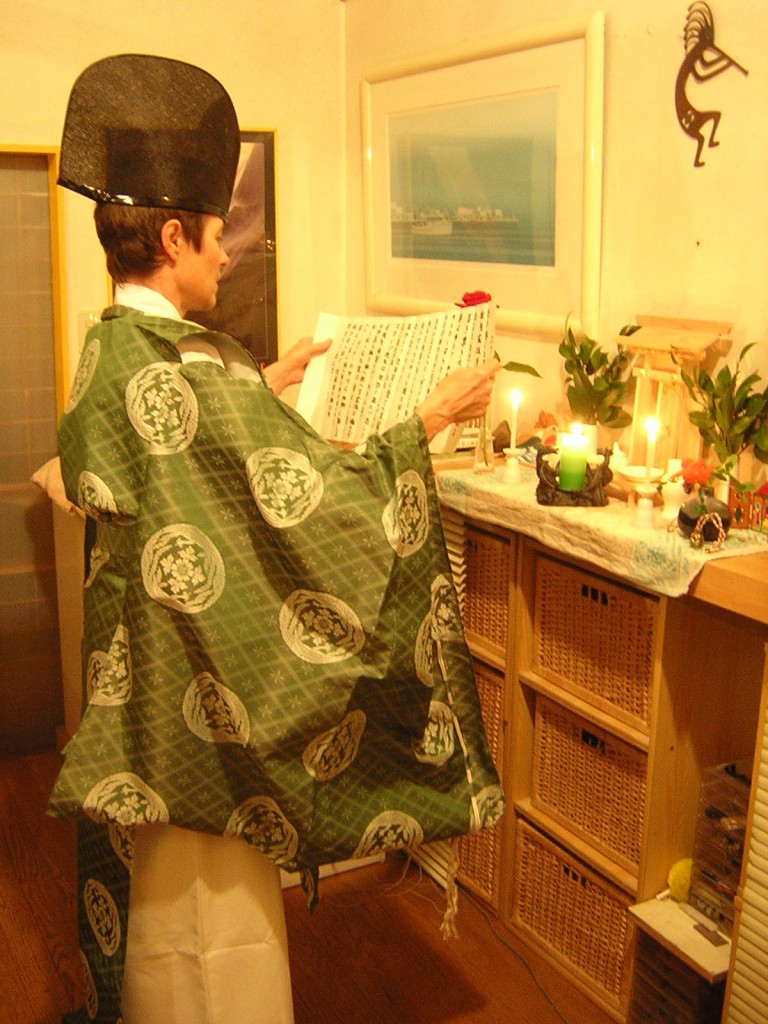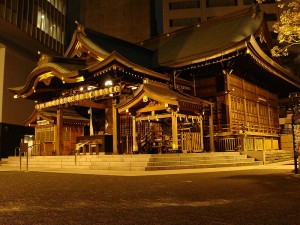
1) I believe you may be the first qualified non-Japanese female priest. How did that come about?
Actually, Rev. Ann Evans, an accomplished priestess who has a lovely shrine near Victoria, Canada, was the first non-Japanese Shinto priestess as far as I know. [Reports suggest the shrine is non-functioning.] I presume she was licensed. Her acquaintance with Shinto was through Rev. Koichi Barrish near Seattle, who had been introduced to Shinto through his knowledge of Aikido. He was initiated through Tsubaki Grand Shrine in Mie Prefecture. Within Shrine Shinto, Tsubaki Grand Shrine has been something of an internationally-minded maverick. The shrine could get away with this (and also took a stand against militarism prior to and during World War II) on account of being too important to crush. It was second in importance only to Ise Jingu nearby, but the shrine suffered economic hardship and decreased visibility as a result, however.
Kompira Shrine, more formally known as Kotohiragu, was more conservative, but because it represents the god of international trade and travel and because there was a Kompira branch shrine in Hawaii, they felt they had good reason to consider taking in a foreigner. It is an international age after all.
My own introduction to Shinto was through efforts by a community of Japanese and foreigners to save a small mountain on the western edge of Tokyo, which had a Kompira shrine that had fallen into disuse. The mountain, they learned, could be saved from destruction if the shrine were revitalized and ceremonies held on a regular basis. Through this effort, many foreigners living in Tokyo were able to learn about Shinto, and were finding that it has some surprisingly positive aspects. I wanted to help out in a meaningful way, so I offered to become a priestess. Because I was raised as a Buddhist (in Salt Lake City), my family had no objection to this.
2) Could you tell us what the training involved?
The formal training of Kotohiragu Honkyo consists of a five-day course in Shikoku held annually in May. Prior to attending, however, there is a tacit understanding that one will have already received much training and basic knowledge at one’s local shrine. (I went with very little.) One must of course be fluent in Japanese. It is also considered normal to have memorized several standard prayers.

Kotohiragu, commonly known as Konpira Shrine, in Shikoku (photo by Joe Jones)
Course participants wear white hakamas and kimonos, participate in formal shrine ceremonies, practice and perform standardized ceremonies in groups, attend classes on subjects such as shrine history, prayer composition, specialized purification ceremonies, formal dressing, etc. The teachers never fail to surprise and challenge the students. This year, the course included a special ceremony for Japan’s recovery after the March disaster, for which we studied a special prayer written by the shrine’s historian. There are written tests each year. Students have given impromptu sermons, written essays on unfamiliar kanji and memorized new prayers. They practice the discipline of a traditional Japanese lifestyle. This has never been too hard, though, because everyone works as a group, and people with greater abilities help those with lesser. By participating I have come to appreciate how Japanese society really works.
3) Does the licence qualify you to carry out ceremonies anywhere, or just at Kompira shrines? And do you currently hold a position?
My license qualifies me to perform ceremonies at any Shinto shrine. The other factor is demand. I hold no formal position, but would be welcome to participate or even lead ceremonies at the Asakawa Kompira Shrine in western Tokyo. I just live too far to do that regularly.
4) What kinds of rituals and ceremonies have you presided over?
The kinds of ceremonies one can perform in Shinto are virtually limitless, and depend on the needs of one’s community. Caitlin Stronell, our other foreign priestess at Asakawa Kompira has suggested “divorce ceremonies” and purification rituals for rape victims. I have performed weddings, ground-breaking ceremonies, an exorcism of a haunted house, purification ceremonies for people who felt they were under a curse, formal mid-summer and New Year’s festivities, monthly shrine ceremonies and divination ceremonies involving fire or a resonating cask of steaming rice placed over boiling water. I have also practiced, but not yet led, the misogi ceremony, involving purification by water, typically by standing under a waterfall. In all cases, I would say the objective is to provide a venue conducive to experiencing divine presence by all participants. Anything you can do to help people emotionally or spiritually can become the focus of a special ceremony.
(For Part Two of the interview, click here.)

Leave a Reply